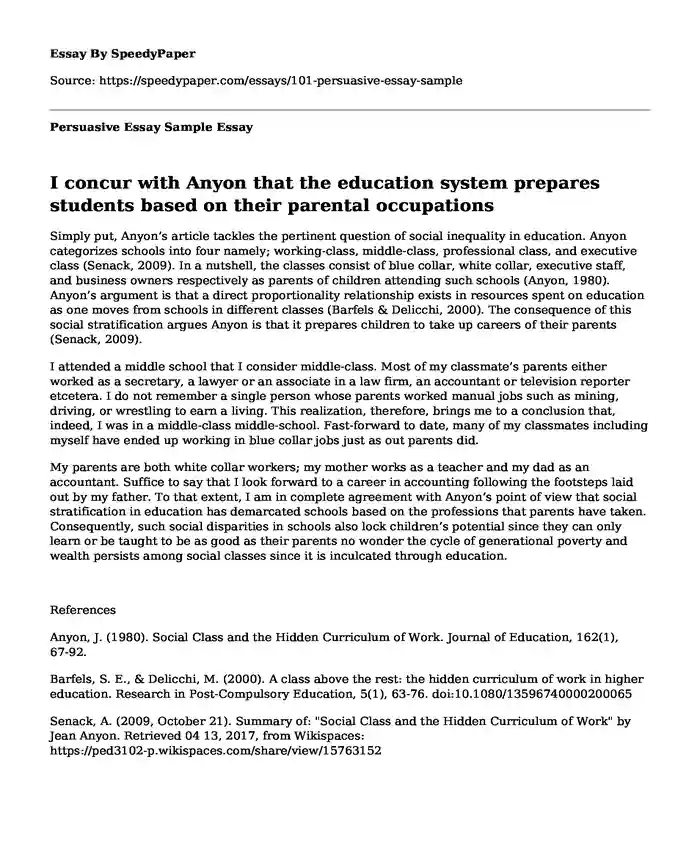
| Essay type: | Persuasive essays |
| Categories: | School |
| Pages: | 2 |
| Wordcount: | 400 words |
I concur with Anyon that the education system prepares students based on their parental occupations
Simply put, Anyon’s article tackles the pertinent question of social inequality in education. Anyon categorizes schools into four namely; working-class, middle-class, professional class, and executive class (Senack, 2009). In a nutshell, the classes consist of blue collar, white collar, executive staff, and business owners respectively as parents of children attending such schools (Anyon, 1980). Anyon’s argument is that a direct proportionality relationship exists in resources spent on education as one moves from schools in different classes (Barfels & Delicchi, 2000). The consequence of this social stratification argues Anyon is that it prepares children to take up careers of their parents (Senack, 2009).
I attended a middle school that I consider middle-class. Most of my classmate’s parents either worked as a secretary, a lawyer or an associate in a law firm, an accountant or television reporter etcetera. I do not remember a single person whose parents worked manual jobs such as mining, driving, or wrestling to earn a living. This realization, therefore, brings me to a conclusion that, indeed, I was in a middle-class middle-school. Fast-forward to date, many of my classmates including myself have ended up working in blue collar jobs just as out parents did.
My parents are both white collar workers; my mother works as a teacher and my dad as an accountant. Suffice to say that I look forward to a career in accounting following the footsteps laid out by my father. To that extent, I am in complete agreement with Anyon’s point of view that social stratification in education has demarcated schools based on the professions that parents have taken. Consequently, such social disparities in schools also lock children’s potential since they can only learn or be taught to be as good as their parents no wonder the cycle of generational poverty and wealth persists among social classes since it is inculcated through education.
References
Anyon, J. (1980). Social Class and the Hidden Curriculum of Work. Journal of Education, 162(1), 67-92.
Barfels, S. E., & Delicchi, M. (2000). A class above the rest: the hidden curriculum of work in higher education. Research in Post-Compulsory Education, 5(1), 63-76. doi:10.1080/13596740000200065
Senack, A. (2009, October 21). Summary of: "Social Class and the Hidden Curriculum of Work" by Jean Anyon. Retrieved 04 13, 2017, from Wikispaces: https://ped3102-p.wikispaces.com/share/view/15763152
Cite this page
Persuasive Essay Sample. (2019, Apr 23). Retrieved from https://speedypaper.net/essays/101-persuasive-essay-sample
Request Removal
If you are the original author of this essay and no longer wish to have it published on the SpeedyPaper website, please click below to request its removal:
- Free Essay on Food Consumption Factors
- Essay Example: Analysis of The Star Agency PR Company
- Counting in Preschool - Teaching Essay Example
- Finding Forrester - Movie Review Essay Sample
- Essay Sample: Gendered Stereotypes Portray Masculinity Preference and Femininity Dislike
- Means Test Essay Example
- Paper Example on the Financial Expertise of Audit Committees
Popular categories




